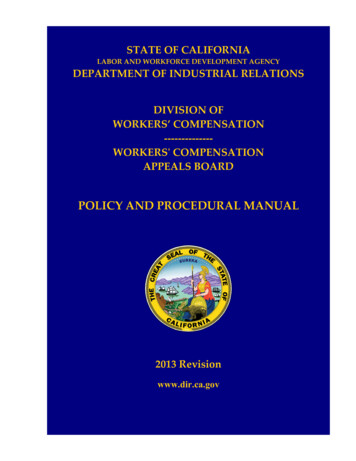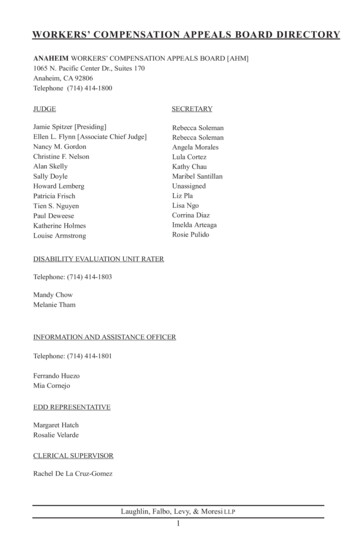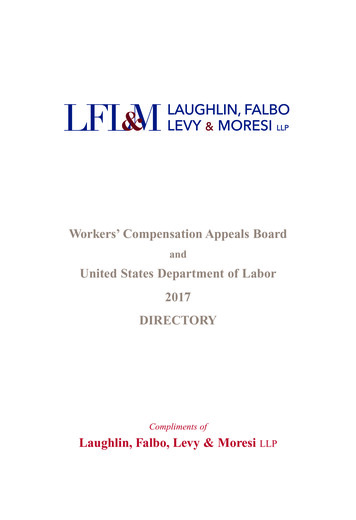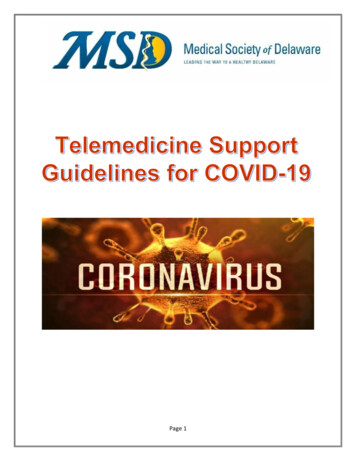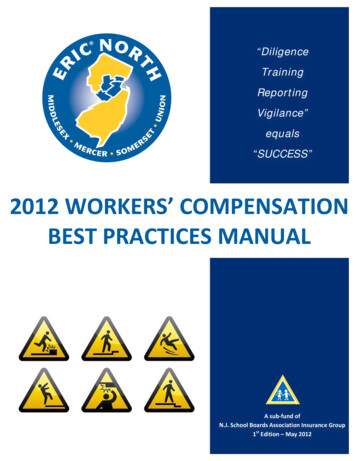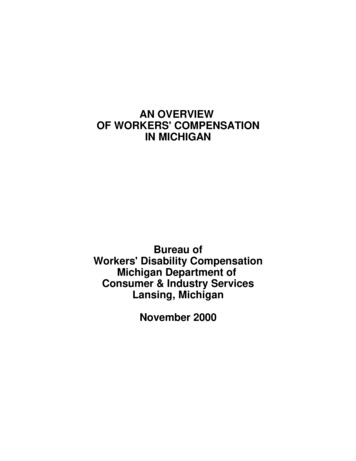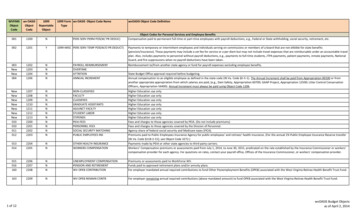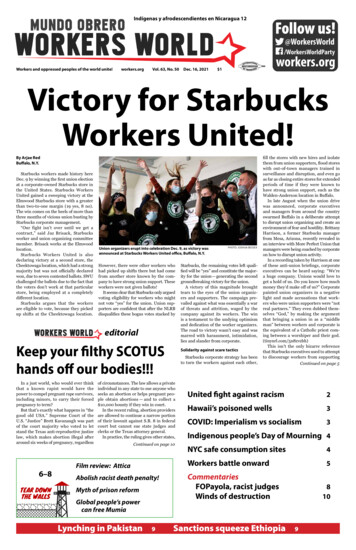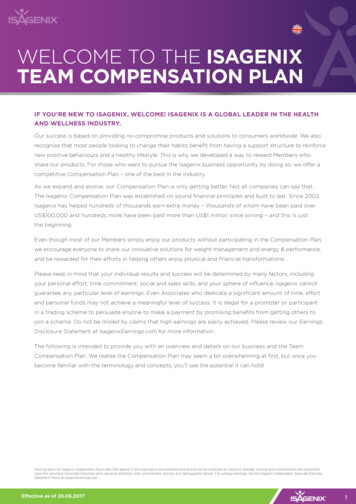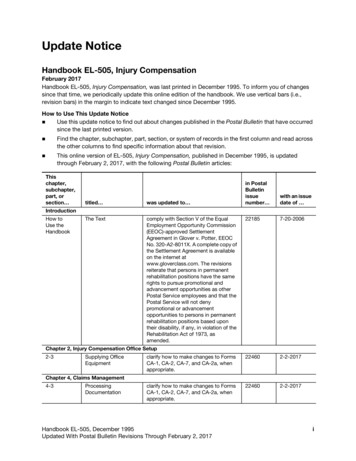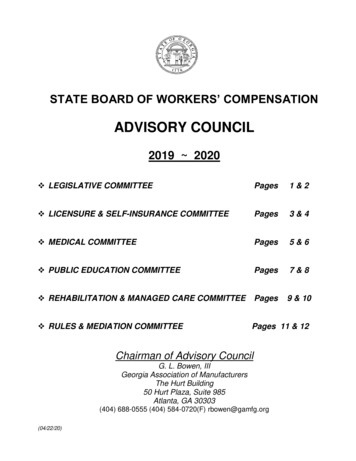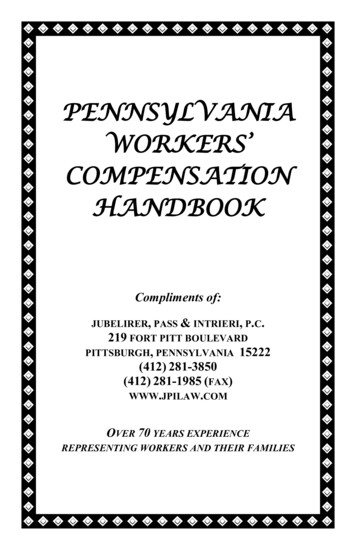
Transcription
nts of:JUBELIRER, PASS & INTRIERI, P.C.219 FORT PITT BOULEVARDPITTSBURGH, PENNSYLVANIA 15222(412) 281-3850(412) 281-1985 (FAX)WWW.JPILAW.COMOVER 70 YEARS EXPERIENCEREPRESENTING WORKERS AND THEIR FAMILIES
PENNSYLVANIA WORKERS’COMPENSATION HANDBOOKTHIS HANDBOOK HAS BEEN PREPARED BY THE LAW FIRM OFJUBELIRER, PASS & INTRIERI, P.C. TO PROVIDE ASSISTANCE TO INDIVIDUALSWHO MAY BE ENTITLED TO BENEFITS UNDER THE PENNSYLVANIAWORKERS’ COMPENSATION ACT. IT IS NOT INTENDED AS A SUBSTITUTEFOR LEGAL COUNSEL, NOR IS IT DESIGNED TO ANSWER ALL QUESTIONSWHICH MIGHT ARISE. THIS HANDBOOK HAS BEEN SET UP IN A “QUESTIONAND ANSWER” FORMAT TO EXPLAIN BASIC PRINCIPLES IN EASILYUNDERSTOOD LANGUAGE. IF THE HANDBOOK DOES NOT ADDRESSSPECIFIC PROBLEMS OR CONCERNS, PLEASE FEEL FREE TO CONTACT THEOFFICES OF JUBELIRER, PASS & INTRIERI, P.C. AT (412) 281-3850.THE LAW FIRM OF JUBELIRER, PASS & INTRIERI, P.C. HAS BEENREPRESENTING MEMBERS OF ORGANIZED LABOR AND THEIR FAMILIES FOROVER 70 YEARS. THIS REPRESENTATION ENCOMPASSES COLLECTIVEBARGAINING NEGOTIATIONS, RESOLVING CONTRACT INTERPRETATIONDISPUTES, AND PROTECTING INDIVIDUALS WHOSE JOB TENURE HAS BEENTHREATENED BY EMPLOYER DISCIPLINE. THIS FIRM ALSO REPRESENTSINJURED INDIVIDUALS AND THEIR FAMILIES IN CLAIMS FOR DAMAGESRESULTING FROM PERSONAL INJURIES. IN ADDITION TO WORKERS’COMPENSATION CLAIMS, THIS INCLUDES CIVIL LITIGATION ARISING FROMINJURIES SUSTAINED IN AUTOMOBILE ACCIDENTS, OR CAUSED BY MEDICALMALPRACTICE, DEFECTIVE PRODUCTS, OR UNSAFE PREMISES.REPRESENTATION IN WORKERS’ COMPENSATION CLAIMS, SOCIALSECURITY DISABILITY, AND CLAIMS FOR DAMAGES ARISING FROMPERSONAL INJURIES ARE HANDLED ON A CONTINGENT FEE BASIS. NO FEESARE PAID UNLESS YOU ARE SUCCESSFUL AND THERE IS A MONETARYRECOVERY. APPOINTMENTS TO DISCUSS ANY OF THE ABOVE CASES CAN BESCHEDULED WITH ONE OF THE FIRM’S ATTORNEYS AT NO CHARGE. INADDITION TO SCHEDULING APPOINTMENTS AT OUR OFFICES INPITTSBURGH, THE FIRM’S ATTORNEYS OFTEN SCHEDULE APPOINTMENTSAT THE OFFICES OF THE LOCAL UNIONS THAT WE REPRESENT.
TABLE OF CONTENTSINTRODUCTIONCHAPTER 1 - SCOPE OF THE LAW1.WHAT IS WORKERS’ COMPENSATION?2.TO WHOM DOES THE PENNSYLVANIA WORKERS’COMPENSATION ACT APPLY?3.WHO IS ENTITLED TO BENEFITS UNDER THEPENNSYLVANIA WORKERS’ COMPENSATION ACT?4.WHAT TYPE OF INJURIES ARE COVERED BY THEPENNSYLVANIA WORKERS’ COMPENSATION ACT?5.WHAT KIND OF BENEFITS ARE AVAILABLE TO ANINJURED WORKER OR A SURVIVING FAMILY MEMBER?6.WHAT IS THE FIRST THING AN INDIVIDUALINJURED ON THE JOB SHOULD DO?7.WHAT KIND OF NOTICE IS REQUIRED?8.WHEN DOES COMPENSATION START?3
9.HOW IS THE WEEKLY COMPENSATION BENEFITCALCULATED?10.WHAT IS THE MAXIMUM COMPENSATION RATE?11. CAN AN INJURED INDIVIDUAL SUE AN EMPLOYEROR A CO-EMPLOYEE WHOSE NEGLIGENCE CAUSED THE INJURY?12.IS THE EMPLOYER OR WORKERS’ COMPENSATIONINSURANCE CARRIER LIABLE FOR PAIN AND SUFFERING ORMENTAL ANGUISH?13.CAN AN INJURED INDIVIDUAL SUE THIRD PARTIESWHOSE NEGLIGENCE CAUSED THE INJURY?14.DOES THE NEGLIGENCE OR FAULT OF THE INJUREDWORKER AFFECT THE CLAIM FOR BENEFITS?CHAPTER 2 - TYPE OF BENEFITS15.WHAT IS TOTAL DISABILITY?16.WHAT IS PARTIAL DISABILITY?17.HOW IS THE COMPENSATION RATE FOR PARTIALDISABILITY BENEFITS CALCULATED?18.HOW LONGCONTINUE TO BE PAID?WILL4COMPENSATIONBENEFITS
19.WHAT ARE SPECIFIC LOSS BENEFITS?20.WHAT ARE DISFIGUREMENT BENEFITS?21.WHAT ARE DEATH BENEFITS?22.HOW ARE DEATH BENEFITS PAID?CHAPTER 3 - PROCEDURE23.HOW WILL AN INJURED WORKER KNOW IF A CLAIMHAS BEEN ACCEPTED?24.WHAT IS THE DIFFERENCE BETWEEN A NOTICE OFCOMPENSATION PAYABLE AND A NOTICE OF TEMPORARYCOMPENSATION PAYABLE?25.WHAT IS THE TIME LIMIT TO APPEAL A CLAIMWHICH HAS BEEN DENIED?26.WHAT IS THE TIME LIMIT TO REOPEN A CASEWHERE THE INJURED WORKER PREVIOUSLY RECEIVED BENEFITS?27.WHAT IS THE DIFFERENCE BETWEEN A SUSPENSIONOF COMPENSATION AND A TERMINATION OF BENEFITS?28.WHAT IS A FINAL RECEIPT?5
29.CAN THE INSURANCE CARRIER FORCE THE INJUREDWORKER TO BE EXAMINED BY ONE OF THEIR DOCTORS?30.IF THE INSURANCE CARRIER’S DOCTOR FEELS THEWORKER IS RECOVERED, WILL THE WEEKLY WORKERS’COMPENSATION CHECKS STOP?31. WHAT SHOULD AN INJURED WORKER DO IF AWORKERS’ COMPENSATION CLAIM IS DENIED?32.WHAT SHOULD AN INJURED WORKER DO IF APETITION IS FILED SEEKING TO STOP OR REDUCE BENEFITS?CHAPTER 4 - MEDICAL BENEFITS33.WHAT TYPE OF MEDICAL EXPENSES ARE COVERED?34.DOES AN INJURED WORKER HAVE TO TREAT WITHTHE EMPLOYER’S DOCTOR?35.CAN THE EMPLOYER FORCE AN INJURED WORKERTO TREAT WITH A PARTICULAR PHYSICIAN?36.DOCTOR?WHEN CAN AN INJURED WORKER SEE HIS OWN37.SURGERY?CAN AN INJURED WORKER BE FORCED TO HAVE6
CHAPTER 5 - SPECIAL SITUATIONS38.IS AN EMPLOYEE ENTITLED TO WORKERS’COMPENSATION BENEFITS IF INJURED GOING TO OR COMINGHOME FROM WORK?39. IS AN EMPLOYEE WHO SUSTAINS INJURIES AT ANEMPLOYER-SPONSORED SOCIAL OR ATHLETIC EVENT ENTITLED TOCOMPENSATION?40.IF AN EMPLOYEE WHO PREVIOUSLY SUSTAINED ACOMPENSABLE INJURY RETURNS TO WORK AND LATEREXPERIENCES PROBLEMS AT HOME, CAN WORKERS’COMPENSATION BENEFITS BE REINSTATED?41.CAN AN EMPLOYEE RECEIVE WORKERS’COMPENSATION BENEFITS FOR A DISABILITY CAUSED BY WORKRELATED MENTAL STRESS?42.CAN A HEART ATTACK BE CONSIDERED A WORKRELATED INJURY?43.CAN THE INSURANCE CARRIER HIRE A PRIVATEINVESTIGATOR AND CONDUCT SURVEILLANCE OF AN INDIVIDUALRECEIVING WORKERS’ COMPENSATION BENEFITS?44.CAN AN EMPLOYEE COLLECT PENSION BENEFITSAND WORKERS’ COMPENSATION BENEFITS AT THE SAME TIME?7
45.CAN AN INDIVIDUAL WHO IS RECEIVING WORKERS’COMPENSATION BENEFITS ALSO RECEIVE SOCIAL SECURITYDISABILITY BENEFITS AT THE SAME TIME?46.CAN AN INJURED WORKER RECEIVE WORKERS’COMPENSATION BENEFITS AND SOCIAL SECURITY RETIREMENTBENEFITS AT THE SAME TIME?47.IF A CLAIM FOR WORKERS’ COMPENSATIONBENEFITS HAS BEEN DENIED, DO YOU RECOMMEND APPLYING FORSICK AND ACCIDENT BENEFITS?48.SHOULD AN INJURED WORKER SETTLE A WORKERS’COMPENSATION CLAIM FOR A LUMP SUM AMOUNT?49.HOW SHOULD AN INDIVIDUAL GO ABOUTSELECTING AN ATTORNEY IN A WORKERS’ COMPENSATION CASE?50.HOW DO YOUR FEES WORK?8
INTRODUCTIONAccording to recent studies, every day 183Americans die from work-related injuries andoccupational diseases. On the same day, morethan 39,000 non-fatal injuries and illnesses willoccur in America’s workplaces. Unfortunately,instead of focusing on making the workplace safera company’s “bottom line” is often moreimportant than its employees. Employers and theinsurance industry have spent millionspropagating the myth that many of these claimsare fraudulent. This is simply not true. Mostpeople seeking workers’ compensation benefitsare legitimate, and want to return to work as soonas possible. No one is getting rich collectingworkers’ compensation benefits.Workers’compensation only pays a portion of an injuredemployee’s loss. It does not pay for the full wageloss, pain and suffering, or compensate thatworker for the loss of enjoyment of many of life’spleasures.Despite its many shortcomings,workers’ compensation benefits are still the mostimportant resource available to an injured worker.It is vitally important that you understand yourrights and make sure that your employer meets itsobligation under the law.9
CHAPTER 1 - SCOPE OF THE LAW1.What is workers’ compensation?The Pennsylvania Workers’ CompensationAct is the state law established to protect individualswho have sustained injuries on the job. The Actprovides for weekly disability income benefits, medicaltreatment, and death benefits to surviving familymembers of workers killed on the job. However,workers’ compensation only pays a portion of anindividual’s overall loss. It does not reimburse aninjured worker for the entire wage loss, nor does itprovide compensation for pain and suffering. Despiteits many shortcomings, workers’ compensation is themost important resource available to an injuredworker.2.To whom does the Pennsylvania Workers’Compensation Act apply?The Pennsylvania Workers’ CompensationAct covers nearly every Pennsylvania worker, includingpublic employees. Employers must providecompensation insurance for all of their employees,including part-time workers, professionals andexecutives. Non-profit corporations, unincorporated10
businesses, and even employers with only oneemployee, must comply with the Act’s requirements.Most employers purchase workers’compensation insurance coverage from a privateinsurance carrier. However, if an employer hassufficient resources, it may “self-insure”. An employerwho fails to maintain workers’ compensationinsurance coverage can be subjected to criminalprosecution and substantial monetary fines. Althoughmost Pennsylvania employees are protected by theprovisions of the Act, there are some exemptions. Themost common exemptions are federal civilianemployees, railroad workers, longshoremen, anddomestic servants.3.Who is entitled to benefits under thePennsylvania Workers’ Compensation Act?In order to be entitled to benefits, theinjured worker must be an “employee”--this meansthat the individual’s work must be under the directionand control of the employer. Independent contractorsare not covered. Trade persons hired for a specific joband who maintain control over their work are notemployees. However, in many instances an individual’sstatus as an employee or independent contractor is notalways clear. Employers often attempt to haveindividuals sign an acknowledgement that they are11
independent contractors in an attempt to avoidresponsibility for workers’ compensation coverage.Such written acknowledgements will not defeat a claimfor benefits if the employer exercised direction andcontrol over the work performed by the injuredindividual. Competent legal counsel is needed to assesswhether an employment relationship existed therebyenabling the injured individual to collect workers’compensation benefits.4.What type of injuries are covered by thePennsylvania Workers’ Compensation Act?The law applies to all injuries oroccupational diseases occurring in Pennsylvania,regardless of the place where you were hired. Workdoes not have to be the sole cause of an injury. Anemployer takes an employee “as is”, meaning thatcompensation is payable even if a relatively minorincident aggravates or substantially contributes to aninjury or an occupational disease. There is norequirement that the injury arise from an “accident”-injuries that develop gradually, from cumulativetrauma, are also covered. An example would be carpaltunnel syndrome, or injuries to the low back or kneesfrom repetitive heavy lifting or constant kneeling.Employees should always inquire as towhether a particular condition is work-related. This12
means discussing it with your union representative,your doctor, and consulting a knowledgeable attorney.Don’t let your employer or its workers’ compensationinsurance carrier tell you that you are not entitled tobenefits because you had a similar problem previously.5.What kind of benefits are available to aninjured worker or a surviving familymember?The available benefits include: (a) wageloss benefits for total disability; (b) wage loss benefitsfor partial disability; (c) specific loss benefits forpermanent loss of use of certain parts of the body byamputation or loss of function; (d) disfigurementbenefits for a permanent scar on the head, neck orface; (e) death benefits to a workers’ surviving spouseor dependents; (f) reasonable and necessary medicalexpense, even if the injuries do not result in lost timefrom work. The benefits enumerated above areexplained in greater detail later in this Handbook.6.What is the first thing an individual injuredon the job should do?The answer to this question is very simple-NOTIFY YOUR EMPLOYER THAT YOU WEREINJURED ON THE JOB. Unless notice of the injury13
is given to the employer within 21 days, nocompensation shall be due until notice is given. Ifnotice of the injury is not provided within 120 days, nocompensation will be allowed. The time for givingnotice of an injury does not begin to run until theemployee knows, or by the exercise of reasonablediligence should know, of the existence of the injuryand its possible relationship to his or her employment.No matter how minor the injury mayappear the safest course of action is to report theinjury immediately. Often a worker will be injured, butwill complete their assigned duties without reportingthe injury thinking that the pain will go away. The nextday that individual may not be able to get out of bed.Although it is not too late to give notice, youremployer will be less likely to pay the claim without afight if notice was not given the day the injuryoccurred.7.What kind of notice is required?There is no requirement that notice of aninjury be in writing. However, reporting an injury inwriting may avoid situations where an employer deniesever being advised that you suffered an injury at work.Always insist on receiving a copy of written accidentreports.14
Notice of an injury is sufficient if youdescribe your physical complaints, and unequivocallystate that it was caused by your work activity. Merelycalling to report off work due to back pain does notconstitute notice of an injury. You must go further andindicate that the back pain is attributable to your workactivity. If there was a specific event that gave rise tothe pain, describe that event. Conversely, if the painarose while you were performing your normal workactivity, describe what you were doing when youexperienced the pain. Telling a co-worker that youwere hurt on the job does not constitute notice to youremployer. You must advise someone in a supervisorycapacity, such as a foreman or immediate supervisor.8.When does compensation start?Compensation for lost wages is paidbeginning with the eighth (8th) day of disability.Compensation is not paid for the first seven (7) daysunless the period of disability lasts fourteen (14) daysor more, in which event the employee receivescompensation for the first seven (7) days of disability.9.How is the weekly compensation benefitcalculated?15
If an injured worker is totally disabled, theincome loss benefits are two-thirds of the pre-injuryaverage weekly wage. The maximum amount payablecan never exceed the statewide average weekly wage,which changes each year. The pre-injury averageweekly wage is not based on an individual’s hourly ratemultiplied by 40 hours. Instead, it includes overtimecompensation, incentive pay, shift differentials andbonuses. The average weekly wage is based upon grosswages from all employers--not take home pay. If aninjured individual is working for more than oneemployer, a situation known as “concurrentemployment”, the wages from both employers areutilized in calculating the pre-injury average weeklywage.The most common method of calculatingthe pre-injury average weekly wage involves a reviewof earnings during the four calendar quartersimmediately prior to the injury. The three highestquarters are averaged and that becomes the pre-injuryaverage weekly wage. For individuals who have notworked for the employer for at least one year prior tothe date of injury, or who work in a strictly seasonableoccupation, alternate methods of calculating the preinjury average weekly wage are available. Although thecalculation of the pre-injury average weekly wage mayseem straightforward, it is always best to check theemployer’s calculations. Any increase in the averageweekly wage will result in an increase in the weekly16
workers’ compensation benefit, and this may meanthousands of extra dollars in benefits over the life ofthe claim.For low wage earners, there is also aminimum compensation rate. The minimumcompensation benefit is the lower of 50% of thestatewide average weekly wage, or 90% of the workers’average weekly wage.10.What is the maximum compensation rate?The maximum compensation rate changesJanuary 1 of each year to equal the statewide averageweekly wage. The new maximum only applies toinjuries which occur, and occupational diseases whichbecome disabling, during the year the maximumcompensation rate is in effect. Although the maximumcompensation rate increases each year, an individual’sworkers’ compensation rate is fixed or “locked in” asof the date of injury and will not increase. There is no“cost of living” increase or adjustment in workers’compensation rates.stThe following chart reflects the statewideaverage weekly wage for 2012 and the correspondingmaximum compensation rate for the past five (5)years.17
2 779.00 807.00 836.00 845.00 858.00 888.0011.Can an injured individual sue an employeror a co-employee whose negligence causedthe injury?No.ThePennsylvaniaWorkers’Compensation Act is the exclusive remedy, whichmeans that an employer is immune from negligencelawsuits by employees or their families, except underextremely limited situations. The only exceptions are:a)Uninsured employers--The immunityprovision does not protect an employerwho fails to obtain the required insurancecoverage under the Act;b)An occupational disease that is notcovered by the Act;18
c)Injuries sustained while not in the scopeof employment--An example of an injurysustained while not in the scope ofemployment would be the following: Amechanic employed by a bus company isinjured on his day off when a bus ownedby his employer collides with theemployee’s private personal automobile.Although injured as a result of hisemployer’s negligence, since he was not inthe scope of his employment at the timethe injuries were sustained, a suit againstthe employer would be permitted.d)Intentional injuries motivated by purelypersonal reasons--Note that even if theemployer’s conduct is considered recklessor an intentional violation of safetystandards, this would not be enough toovercome the bar to a civil lawsuit. Only ifthe company intentionally injured theworker for personal reasons could theemployee file a lawsuit.The immunity from personal injurylawsuits also extends to co-workers, includingsupervisors, no matter how negligent they were incausing the injury.19
12.Is the employer or workers’ compensationinsurance carrier liable for pain andsuffering or mental anguish?No. The employer and/or its workers’compensation insurance carrier are not liable for painand suffering or mental anguish.13.Can an injured individual sue third partieswhose negligence caused the injury?Yes. Only employers and co-workers areshielded from lawsuits. Workers can sue otherindividuals or companies whose negligence caused theinjury or the occupational disease. Some examples ofsuch third party lawsuits are:a)Motor vehicle collisions involving vehiclesoperated by third parties, or suits againstgovernmental entities alleging unsafe ibutors of unsafe machinery, such asunguarded saws, shears or punch presses;c)Manufacturers and distributors of toxicchemicals;20
d)Unsafe industrial equipment, such asdefective ladders or scaffolding;e)Owners of premises that permit unsafeand dangerous conditions to exist, such asicy sidewalks, or steps without handrails.Injured workers should have their casesreviewed to assess the potential for third partylawsuits. The awards in such lawsuits may be severaltimes the amount recoverable under workers’compensation. This is due to the fact that third partylawsuits permit the recovery of damages for pain andsuffering, mental anguish, loss of consortium, and lossof enjoyment of life.14.Does the negligence or fault of the injuredworker affect the claim for benefits?No. Workers’ compensation is a “nofault” system, which means that an individual’sbenefits cannot be denied even if the employee’scarelessness caused the injury. This means that theemployer cannot assert as a defense the fact that theinjury occurred as a result of the injured worker’scarelessness. As previously noted, the employer’snegligence does not result in an award for pain andsuffering or other compensatory damages. Theemployee does not collect more if the injury was21
attributable to the employer’s fault. Similarly, theemployee does not collect less if the injury resultedfrom his or her carelessness. For instance, anemployee whose injury was attributable to the failureto wear safety shoes would not forfeit his or her rightto benefits. However, if an injury is attributable to aserious violation of law, or the consumption of drugsor alcohol, no compensation will be allowed.22
CHAPTER 2 - TYPE OF BENEFITS15.What is total disability?The answer to this question depends onwhether the injury date was before or after June 24,1996. As a result of extensive lobbying efforts by theinsurance industry and employers, the legislatureenacted amendments to the Pennsylvania Workers’Compensation Act known as “Act 57”, which wentinto effect June 24, 1996. For injuries that occurredprior to June 24, 1996, an injured worker wasconsidered totally disabled if he was unable to returnto his time of injury occupation, and the employer orinsurance carrier hadn’t demonstrated the availabilityof suitable alternative employment. The employerand/or insurance carrier had the burden to prove thatother work was available to the injured employee.Total disability benefits conceivably could continueindefinitely. In order to convert benefits to partialdisability, the employer was forced to demonstrate thatone of the following applied:a)That the employer actually offered theemployee a job consistent with the injuredworker’s physical limitations; orb)That there was an actual job available withanother employer consistent with theinjured worker’s physical limitations; or23
c)That the injured worker had acted in badfaith during the vocational rehabilitationprocess.Although litigation of these issues stillarises for those injuries which occurred prior to June24, 1996, it is less prevalent since Act 57 has now beenin effect for several years.Under Act 57, if an injured worker hasreceived total disability benefits for a period of 104weeks, that individual can be required to submit to animpairment rating examination requested by theinsurance carrier. The impairment rating examinationis an attempt to quantify the injured worker’s disabilityunder the AMA “Guides to the Evaluation ofPermanent Impairment” otherwise known as the“AMA Guidelines”. If the examiner finds that theinjured worker’s impairment is equal to or greater than50% under the AMA guidelines, total disabilitybenefits continue. However, if the injured worker’simpairment rating is less than 50%, the injured workeris considered to be partially disabled. The distinctionbetween total disability and partial disability is veryimportant, since partial disability benefits will continuefor a maximum period of 500 weeks.Very few injured workers will have animpairment rating equal to or in excess of 50% under24
the AMA guidelines. This is due to the fact that theguidelines do not take into consideration pain or othersubjective criteria. For instance, a treating physician’sopinion that an injured worker is totally disabled fromall forms of gainful employment is totally irrelevant tothe impairment evaluation process. Only catastrophicinjuries will equal or exceed the 50% impairment ratingthreshold, such as individuals who have suffered anamputation of their upper extremity or who have beenrendered paraplegic.16.What is partial disability?Once again, the answer to this questiondepends on whether the injury date was before or afterthe enactment of Act 57. As noted in response to theprior question, if you were injured before June 24,1996, and you were not earning wages, and theemployer had not demonstrated the availability ofsuitable alternative employment, you were consideredtotally disabled. The distinction between total andpartial disability is important because under totaldisability you would continue to receive your fullcompensation rate, and benefits would continueindefinitely. If you had actually returned to work or theemployer had demonstrated the availability of suitablealternative employment, your benefits were reduced,and they would only continue for a maximum periodof 500 weeks.25
However, under Act 57 an employer is nolonger required to demonstrate that suitable alternativeemployment is actually available to the injured worker.Weekly workers’ compensation wage loss benefits canbe changed to partial disability in two ways:1)After the employee has received totaldisability for 104 weeks, by demonstratingthat the impairment rating is less than50% under the AMA guidelines, asdiscussed previously. Converting benefitsto partial disability through an impairmentrating evaluation in and of itself does notreduce the employee’s weekly benefit, butdoes limit the duration of benefits to 500weeks; or2)By demonstrating that the injuredemployee has earning power by utilizing avocational expert to prepare a labormarket survey of jobs consistent with theinjured worker’s education and physicallimitations.Under this scenario, an employer canreduce an injured employee’s wage loss benefits basedupon a list of “phantom jobs”. There is norequirement that any of the prospective employers inthe labor market survey have any openings. Nor is26
there any requirement that the “phantom” employerswould consider hiring someone who is receivingworkers’ compensation benefits. Act 57 shifted theburden to find another job to the injured worker.Previously, the burden was on the employer andinsurance carrier to demonstrate that anotheremployer was willing to hire the injured worker beforethe weekly wage loss benefits could be reduced.17.How is the compensation rate for partialdisability benefits calculated?The benefit rate for partial disability istwo-thirds of the difference between the pre-injuryaverage weekly wage and the earning power after theinjury. The benefit rate for partial disability can neverexceed the applicable maximum compensation rate fortotal disability. Unlike total disability compensation,there is no minimum compensation rate for partialdisability.Compensation is not payable if there is noloss in earning power. For instance, if an individualreturns to work still suffering from residual physicallimitations which prevent performing all of his formerfunctions, but still earns wages equal to or in excess ofthe pre-injury average weekly wage, there is nocompensation payable. In this situation, compensation27
benefits are suspended until the physical or mentaldisability results in a loss of earnings.Merely returning to work at the samehourly rate does not necessarily result in a cessation ofworkers’ compensation benefits. If an individualreturns at the same hourly rate but less hours areavailable in the new position, the injured worker is stillentitled to partial disability benefits to compensate himfor two-thirds of the difference between the pre-injuryaverage weekly wage and his earnings after returning towork.18.How long will compensation benefitscontinue to be paid?If you have read the answers to questions15 and 16, you already know that the answer dependson when you were injured. If your injury occurredbefore June 24, 1996, total disability benefits cancontinue indefinitely. If the employer was successful indemonstrating that suitable alternative work wasactually available, your status would change to a partialdisability recipient and you would then be limited to anadditional 500 weeks of benefits. Any discussion of theparticulars of such litigation is dependent upon theprecise contention of the employer, that is, whetherthey attempted to demonstrate that you were fullyrecovered, or whether they claim you refused available28
work, or failed to participate in good faith invocational rehabilitation efforts.If the injury occurred after June 24, 1996,the effective date of Act 57, the injured worker will inmost instances be limited to receiving total disabilitybenefits for no more than 104 weeks. Benefits willthen be converted to partial disability benefits eitherthrough an impairment rating evaluation, or bydemonstrating that the injured worker has earningpower through the use of a labor market survey of“phantom jobs”. In addition to making it much easierfor the employer and insurance carrier to reduce thebenefits payable to an injured worker, Act 57 alsomade it much easier to limit the length of time thatbenefits are payable. Remember, partial disabilitybenefits can only continue for a maximum period of500 weeks.19.What are specific loss benefits?Specificlossbenefitsrepresentcompensation payable for the amputation orpermanent loss of use of certain parts of the body, lossof hearing or vision, and disfigurement. Compensationfor specific loss can be paid even if the individual hasnot lost any time from work.29
Eligibility for specific loss benefitsrequires that the injured worker suffer a permanentloss of use for all practical intents and purposes. Thisdoes not mean that the affected body part needs to betotally useless; rather, an evaluation must be made asto whether that part of the body is of meaningful valueboth at home and at work. The legislature has assigneda value to particular parts of the worker’s body as setforth on the chart below. Unless a particular body partis set forth on the chart, no benefits are payable. Forexample, there is no specific loss benefit for the loss ofa kidney, or disfigurement benefit for a scar on the lowback or leg.Chart of Specific Loss BenefitsSPECIFIC LOSS ORPERMANENT LOSSOF USEHand .Forearm Arm .Foot .Lower Leg Leg Eye Thumb .Index finger (firstfinger) WEEKS OFCOMPENSATIONHEALINGPERIOD335 weeks370 weeks410 weeks250 weeks350 weeks410 weeks275 weeks100 weeks20 weeks20 weeks20 weeks25 weeks25 weeks25 weeks10 weeks10 weeks50 weeks6 weeks30
Middle finger(second finger) .Ring finger (thirdfinger) Little finger (fourthfinger) One-half thumb,finger .Great toe Any other toe .One-half great toe,other toe .Hearing - completeloss in both ears .Hearing - complete
compensation handbook this handbook has been prepared by the law firm of jubelirer, pass & intrieri, p.c. to provide assistance to individuals who may be entitled to benefits under the pennsylvania workers’ compensation act. it is not intended as a substitute for lega
